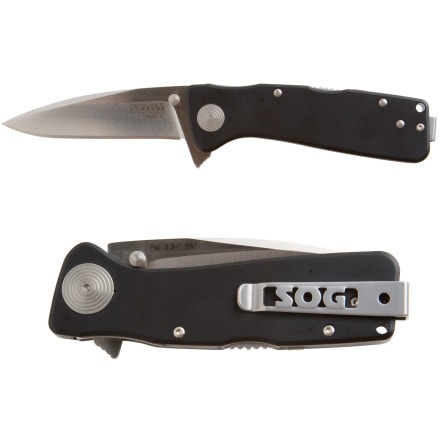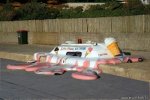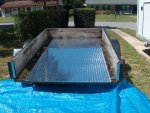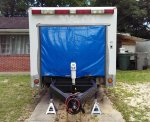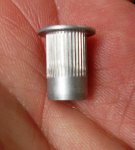Not much of anything to report from last month except it was extremely hot, humid, and it rained a lot! We are entering the most active part of the hurricane season right now, and we're watching a few things in the Atlantic, but nothing threatening at the moment. It's starting to get a little cooler, especially in the mornings, but the rain has not let up very much. You can count on at least one thunderstorm almost every afternoon.
Even though I haven't gotten any physical work done on the project this last month, I have spent a lot of time researching and sourcing materials, supplies, and components I will need to complete the outside. One of the items being the .125 Aluminum Diamond Deck metal I will need to cover the front end. A 4'x8' sheet is $191.00 and I will need two sheets. I'm still pondering that one...
Another item I've been giving a lot of time to is my generator selection and installation. I have a Honda EU3000i generator with electric start, that I was originally planning on using and mounting it in a compartment or on the tongue in an enclosure of some sort. I also have a Honda EU2000i generator, and after coming across another post on another forum about using two smaller generators wired in parallel instead of one larger one, I started having second thoughts.
The Honda crowd is using either the EU1000i or the EU2000i generators for parallel operation. Since I already own a Standard EU2000i that is the series I would be using. Honda even makes a dedicated generator for this purpose called the EU2000i Companion. The internal specs are the same, but the Companion has one 120VAC 20A and one 30A outlet, whereas the Standard unit has two 120VAC 20A outlets and a 12DC outlet.
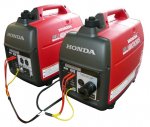 Here are the basic advantages and disadvantages as I see them:
Here are the basic advantages and disadvantages as I see them:
EU2000i Specs
EU3000I Specs
Advantages
1. Greater starting capacity (A/C units) of the paralleled units, now 4000 watts total vs. the 3000 watts of the EU3000i
2. The ability to manage the individual weight of the EU2000i’s at 45 lbs. each for maintenance, repair, etc. as compared to the EU3000i at 134 lbs.
3. Flexibility in configuration and mounting location(s).
4. Ability to shut down one unit when the load is decreased, such as winter time when A/C is not required.
5. Redundancy – if one unit fails to start or breaks down, the other remains to fall back on.
6. One unit can be used as a portable or loaned out, while the other remains to power the camper.
7. This would also free up the EU3000i to use as an additional home backup generator, and it can be converted to run on NG with a kit I just received.
Disadvantages
1. No electric start like the EU3000i has, but pull starting requires almost no effort.
2. Two of everything – double the maintenance, parts, oil, air cleaner, etc.
3. Security of the heavier EU3000i from a theft standpoint vs. the lighter EU2000i.
4. Noise Level –
a. EU2000i - 59 dB(A) @ rated load 53dB(A) @ 1/4 loadb.
b. EU3000i - 58 dB(A) @ rated load, 49 dB(A) @ 1/4 load
c. The EU3000i is a little quieter at ¼ load and I don’t know what the level would actually be with two EU2000i’s running side by side, since the engines are half the size of the EU3000i model. They are so quiet to start with, and if they were in an enclosure of some sort with some quality sound deadening material like
Dynamat Extreme, I really don’t think it will matter much.
5. I would need to purchase another Standard EU2000i or the Companion EU2000i generator at around $1,000.00 - $1,100.00 new, or a good used one. I would also need a set of parallel cables.
Misc.
1. Basic footprint is about the same with two EU2000i’s side by side. Dimensions (L x W x H) are for one unit each.
a. EU2000i - 20.2" x 11.4" x 16.7"
b. EU3000i - 25.9" x 17.6" x 22.0"
Justification
I have attached a post from the AR15 Forum that I found, that pretty well explains the justification for using two EU2000is vs. one EU3000i. No point in me retyping it all over again.
The following is that post:
In researching the Honda EU2000 in parallel vs Honda and Yamaha 3000s, I eventually talked to Speedway sales in Milwaukee area. Riz, the owner, sells and is very informed on both. His experience indicates the Honda, while not spec’d as such, will maintain a higher output in the range of 3000+ watts, for 30 minutes, as opposed to 30 seconds for the boost feature of the Yamaha. He says it will handle heavy loads better overall. However, two EU2000's in parallel will provide 4000 watts startup. As for brand, from my personal experience with generators, including Generac, Onan, and Honda, I've found the Honda to be the most trouble free and easiest to maintain of any out there. I still have a 2500 unit, which saw extensive service for my daughter in the Grand Forks great flood of the Red River last decade. Still works flawlessly.
Personally, after much research into this area, I've decided on two EU2000's paralleled together as opposed to the EU3000. The primary consideration was weight, but there turns out to be other advantages. With the EU3000, at 134# minimum, I would have to use a ramp or lift to handle it as I travel mostly alone. The EU2000’s weighs in at only 46# each. Also, in parallel, the 2-2000’s will provide greater max [and startup] capacity, 4000 watts vs 3000. From a fuel consumption standpoint, with an 13,500 BTU A/C load, which is my primary concern, both the 3000 and 2-2000's will run close to the same amount of time, and the 2-2000's will use less fuel. Here's the calculation:
EU3000: Fuel tank = 3.4 gal. Runtime = 7.2 hr. at full load, 20 hr. 1/4 load.
This equals about 1/3 gal per hour full load and 1/6 gal at 1/4 load.
EU2000: Fuel tank = 1.1 gal. Runtime = 4 hr. at full load, 15 hr. at 1/4 load.
This equals about 1/4 gal per hour full load and 1/14 gal at 1/4 load. Since there will be two units in parallel, the [amount] should be doubled, but then multiplied by 3/4 since the parallel units output 4000 watts vs the 3000's 3000 watts.
If you assume a load of 2400 watts for an A/C unit after startup running continuously, this is about a 3/4 load for the EU3000 and a 6/10 load for the 2-2000's. Assuming the fuel consumption curve is linear for both setups from 1/4 load to full load [which it probably isn't but will be close enough for our calculation], the EU3000 would consume about .3 gal/hr. with a runtime of about 11.5 hours, and the 2-2000's would consume about 1/6 gal/hr. for a run time of about 9.2 hr. While the 2-2000's will have a slightly shorter runtime, their fuel efficiency is substantially greater, since their combined fuel supply is 2.2 gal vs 3.4 for the EU3000. Overall, at this load calculation, the 2-2000's are attaining 4.2 hr./gal vs the 3000 at 3.4 hr./gal.
There are of course other factors to consider, although cost won't be one of them, since net cost will be about the same. These other factors include: the security of the heavier unit from a theft standpoint, the greater start capacity of the paralleled units, now 4000 watts total, the electric start vs manual start, etc. But for this older body, the ability to manage the individual weight of each EU2000 far overrides these other differences.
Posted: 9/16/2012 5:08:58 AM CDT
http://www.ar15.com/forums/t_10_18/659055_Honda_eu3000i_v__eu3000is.html
I already have a 12 gal. aux boat gas tank, so this hose setup with that tank will take care of the extended runtime fuel issue.
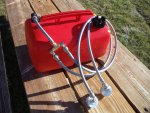 http://www.ebay.com/itm/HONDA-EU200...ITHOUT-TANK-/181313929857?hash=item2a37270281
http://www.ebay.com/itm/HONDA-EU200...ITHOUT-TANK-/181313929857?hash=item2a37270281
By using two smaller generators, my mounting options have increased, as far as using existing compartments. I’m going to do some measuring and test fitting just for my own information, but I still think mounting them in a separate box on the tongue is going to be the better option, even though it will cost more.
The advantages of mounting them on the tongue are:
1. Frees up compartment space for other installed appliances like a water heater, etc. or camping gear.
2. No possible way for gasoline fumes to enter the passenger compartment, and much easier and safer to refuel.
3. Easier to locate and mount the 12 gal Aux fuel tank I have and fuel it. It also has a fuel level gauge built into the cap, so it will be easier to see.
4. If I convert them to run on propane, the tanks will most likely be mounted on the tongue also, so the LPG lines will be much shorter.
5. Easier to cool and vent the exhaust.
6. Easier to run wiring to the main electrical panel, since it’s just on the other side of the front wall.
7. Less noise transmitted to the passenger compartment.
8. Less vibration transmitted to the passenger compartment, especially if I mount the enclosures on rubber donut type isolators, in addition to the rubber feet on the generators themselves.
That's all for now...








